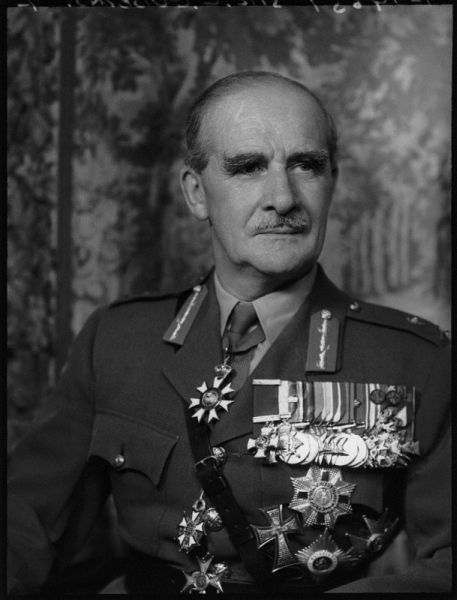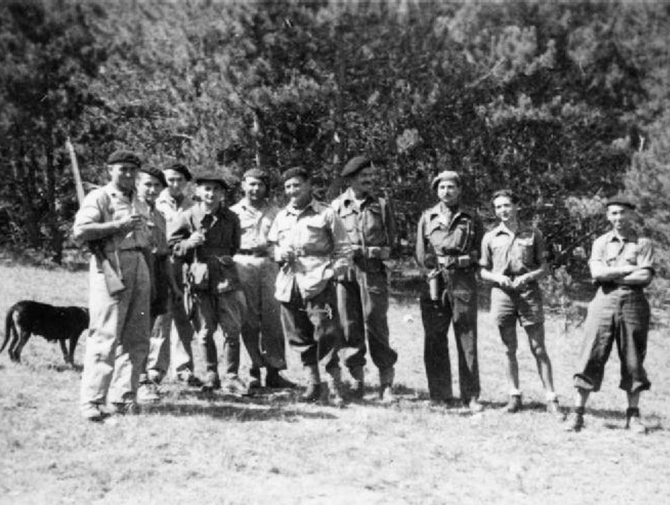Gubbins, Colin McVean
- Date of birth:
- July 2nd, 1896 (Tokyo, Japan)
- Date of death:
- February 1st, 1976 (Stornoway/Outer-Hebrides, United Kingdom)
- Service number:
- 14618
- Nationality:
- British (1801-present, Kingdom)
Biography
Colin McVean Gubbins grew up in Japan where his father worked in the British consular service. After being sent back to England and educated at Cheltenham College, at the age of 19 Gubbins entered the Royal Military Academy at Woolwich. Gubbins served throughout the Great War with the Royal Artillery gaining the Military Cross while serving on the Western Front and getting wounded.In 1919 Gubbins went to Russia where he served under General Edmund Ironside and General Anton Denikin in the White Army. He also served in the Anglo-Irish war of 1919-21. His experiences in Russia and Ireland gave him clear insights into the nature of guerrilla warfare. He joined Military Intelligence and wrote a series of pamphlets on the subject including "The Art of Guerrilla Warfare", "Partisan Leader's Handbook" and "How to Use High Explosives".
After the fall of Poland in September 1939 he was head of Military Intelligence mission to Poles and Czechs in Paris, France. In 1940 he moved to Norway to command the Independent Companies (forerunners of the Commandos), also under MI(R) auspices. For this he was awarded the DSO.
In November 1940 Gubbins was seconded to the Special Operations Executive (SOE), which had recently been established. Besides maintaining his existing connections with the Poles and Czechs, Gubbins was given three tasks: to set up training facilities; to devise operating procedures acceptable to the Admiralty and Air Ministry; and to establish close working relations with the Joint Planning Staff. As head of SOE, Gubbins co-ordinated the activities of resistance movements worldwide. Gubbins' role involved consultation at the highest level with the Foreign Office, the Chiefs of Staff, representatives of the resistance organizations, governments-in-exile, and other Allied agencies including particularly the US Office of Strategic Services (OSS).
In 1946, when the Special Operations Executive had been disbanded, the War Office had no suitable work for him. He became Managing Director of a Scottish carpet company, Grays at Newton of Ayr close to Prestwick Airport. Gubbins spent his last years at his home in the Hebrides, on the Isle of Harris. He was appointed Deputy Lieutenant of the islands area of the Western Isles in 1976.
Promotions:
16 September, 1914: 2nd Lieutenant - Royal Artillery
9 June, 1915: Lieutenant
16 August, 1916: Acting Captain
2 January, 1918: Acting Captain
1 November, 1917 - 27 december 1917: Acting Major (backdated)
12 February, 1918: Captain
22 March, 1919: Adjudant Chef (ADC)
6 October, 1919: commission relinquished
1 October, 1922: temporary commission relinquished as Brigade Major
14 January, 1925: Adjudant
21 April,1926: Seconded to the Staff in India; Area Head Quarters - General Staff Officer, 3rd Grade
20 February, 1928: Staff College Quetta
16 February, 1928: vacated appointment India
1 February, 1931: General Staff Officer, 3rd Grade, War Office
8 April, 1933: Brigade Major Regular Army 4th Division
1 July, 1933: Batalion Major
24 February, 1934: Batalion Major
1 February, 1935: Commission relinquished as Brigade Major
1 October, 1935: Seconded as General Staff Officer, 2nd Grade, War Officer
1 July, 1938: Batalion Lieutenant-Colonel
1 October, 1941: Lieutenant-Colonel
5 December, 1941: Colonel
21 December, 1943: Temporary Major-General
27 April, 1946: retirement - Honoray Major-General
Do you have more information about this person? Inform us!
- Period:
- First World War (1914-1918)
- Rank:
- Lieutenant
- Unit:
- Royal Field Artillery
- Awarded on:
- September 22nd, 1916
"For conspicuous gallantry. When one of his guns and its detachment were blown up by a heavy shell, he organised a rescue party and personally helped to dig out the wounded while shells were falling all round."
- Period:
- Russian Civil War (1917-1922)
- Unit:
- Archangel Expeditionary Force, British Army
- Awarded on:
- 1919
Aide-de-Camp to General Officer Commanding
- Period:
- Second World War (1939-1945)
- Rank:
- Brevet Lieutenant-Colonel
- Unit:
- Independent Companies, Northwest Expeditionary Force, British Army
- Awarded on:
- August 6th, 1940
"For gallant and distinguished services in action in connection with recent operations in Norway."
From 6.5.40 to 23.5.40, Col Gubbins commanded the five Independant Coys in the neighbourhood of BODO.
Later, commencing on 23.5.40, th 24 Gds Bde was placed under his command.
And during the period of the operations displayed sterling qualities of leadership in the handling of his troops operating in a strange and difficult type of country. On several occasions he prsonally led troops which were fighting a rearguard action in contact with the enemy.
His courageous example of devotion to duty though greatly overworked was an inspiration to his men.
The safe withdrawal of the forces from BODO in the face of the enemy and under constant air attack was due to his inspiring leadership, courage and devotion.
- Period:
- Second World War (1939-1945)
- Rank:
- Acting Brigadier
- Unit:
- HQ, Special Operations Executive (SOE), British Government
- Awarded on:
- January 31st, 1941
- Period:
- Second World War (1939-1945)
- Unit:
- HQ, Special Operations Executive (SOE), British Government
- Awarded on:
- 1941
- Period:
- Second World War (1939-1945)
- Rank:
- Temporary Major-General
- Unit:
- HQ, Special Operations Executive (SOE), British Government
- Awarded on:
- January 1st, 1944
- Period:
- Second World War (1939-1945)
- Rank:
- Major-General
- Unit:
- HQ, Special Operations Executive (SOE), British Government
- Awarded on:
- 1944
WO/373/185
- Period:
- Second World War (1939-1945)
- Rank:
- Major-General
- Unit:
- HQ, Special Operations Executive (SOE), British Government
- Awarded on:
- January 1st, 1946
- Period:
- Second World War (1939-1945)
- Rank:
- Temporary Major-General
- Unit:
- HQ, Special Operations Executive (SOE), British Government
- Awarded on:
- February 13th, 1947
Royal Decree no. 34 dated February 13th, 1947.
- Period:
- Second World War (1939-1945)
- Rank:
- Major-General
- Unit:
- HQ, Special Operations Executive (SOE), British Government
- Awarded on:
- May 14th, 1948
WO 373/148/514
- Period:
- Second World War (1939-1945)
- Rank:
- Honorary Major-General
- Unit:
- HQ, Special Operations Executive (SOE), British Government
- Awarded on:
- February 26th, 1954
- Period:
- Second World War (1939-1945)
- Period:
- First World War (1914-1918)
- Period:
- First World War (1914-1918)
- Period:
- First World War (1914-1918)
- Period:
- Second World War (1939-1945)
- Period:
- Second World War (1939-1945)
- Period:
- Second World War (1939-1945)
- Period:
- Second World War (1939-1945)
- Period:
- Second World War (1939-1945)
Sources
- Photo: Find A Grave - Millions of Cemetery Records
- - HEUVEL, C.C. VAN DEN e.a., Verzetsherdenkingskruis, Samsom Uitgeverij, 1985.
- The London Gazette Publication date:15 September 1914 Issue:28902Page:7300
- The London Gazette Publication date:9 July 1915 Supplement:29226Page:6797
- The London Gazette Publication date:22 September 1916 Supplement:29760Page:9275
- The London Gazette Publication date:29 December 1916 Issue:29883Page:12659
- The London Gazette Publication date:2 April 1918 Supplement:30612Page:4114
- The London Gazette Publication date:2 April 1918 Supplement:30612Page:4113
- The London Gazette Publication date:14 May 1918 Supplement:30686Page:5839
- The London Gazette Publication date:28 March 1919 Supplement:31258Page:4137
- The London Gazette Publication date:1 April 1919 Supplement:31268Page:4349
- The London Gazette Publication date:28 October 1919 Supplement:31623Page:13229
- The London Gazette Publication date:6 October 1922 Issue:32753Page:7044
- The London Gazette Publication date:24 February 1925 Issue:33024Page:1349
- The London Gazette Publication date:11 June 1926 Issue:33171Page:3823
- The London Gazette Publication date:16 July 1926 Issue:33183Page:4715
- The London Gazette Publication date:21 February 1928 Issue:33358Page:1221
- The London Gazette Publication date:22 June 1928 Supplement:33396Page:4270
- The London Gazette Publication date:6 February 1931 Issue:33687Page:832
- The London Gazette Publication date:18 April 1933 Issue:33931Page:2630
- The London Gazette Publication date:30 June 1933 Issue:33955Page:4383
- The London Gazette Publication date:23 March 1934 Issue:34035Page:1945
- The London Gazette Publication date:8 February 1935 Issue:34131Page:918
- The London Gazette Publication date:11 October 1935 Issue:34207Page:6377
- The London Gazette Publication date:1 July 1938 Issue:34527Page:4243
- Second Supplement to The London Gazette Issue 34914 published on the 2 August 1940
- The London Gazette Publication date:28 January 1941 Supplement:35059Page:614
- The London Gazette Publication date:26 September 1941 Supplement:35290Page:5642
- The London Gazette Publication date:6 February 1942 Supplement:35448Page:645
- Supplement to The London Gazette Issue 36309 published on the 31 December 1943
- The London Gazette Publication date:4 February 1944 Supplement:36364Page:671
- Supplement to The London Gazette Issue 37407 published on the 28 December 1945
- The London Gazette Publication date:23 April 1946 Supplement:37544Page:2035
- Supplement to The London Gazette Issue 40111 published on the 23 February 1954
- kosmoid.net home
- British Artillery in World War 2
- British Resistance Archive | Churchill's Auxiliary Units | A comprehensive online resource.
- The Dutch Medals page/
- Major General Sir Colin McVean Gubbins
- Recommendation for Award for Gubbins, Colin McVean Rank: Major General ... | The National Archives




























